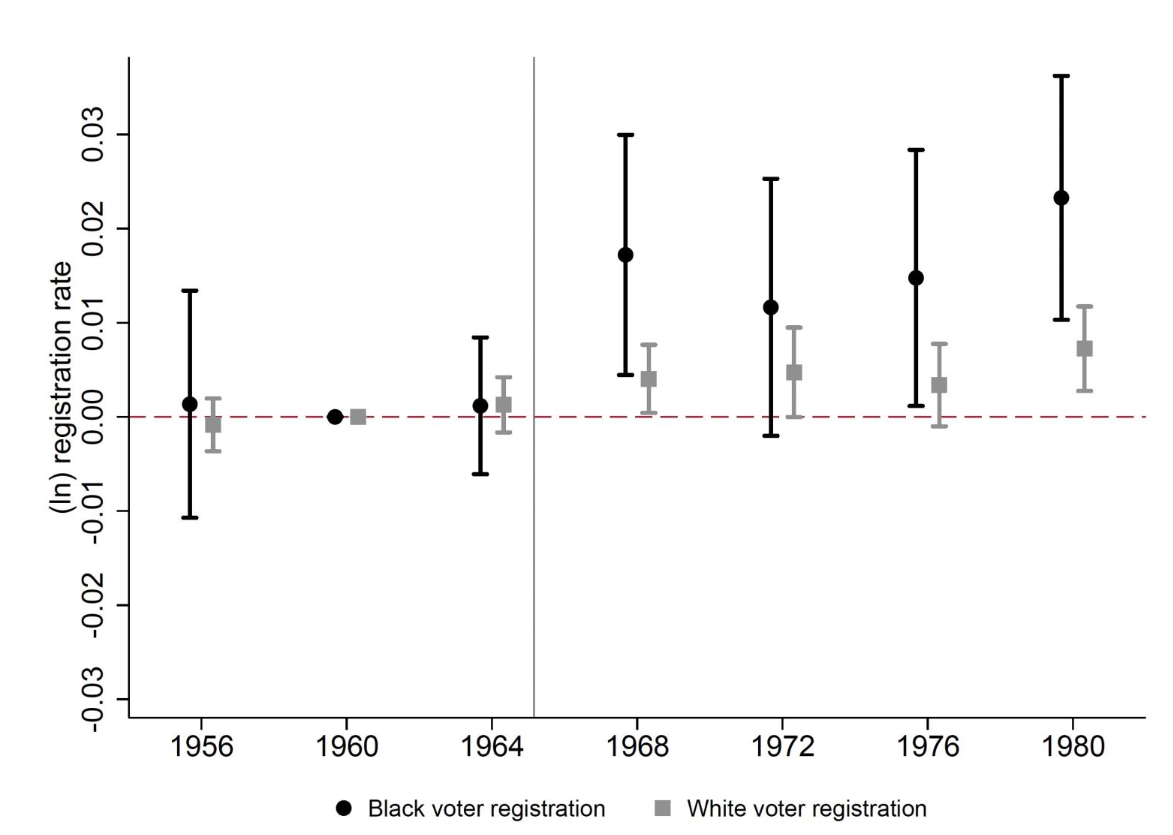
How do majority groups react to policy interventions empowering minorities?
Editor's note: This article previously appeared on VoxEU here.
From affirmative action to political reservation, policy interventions to empower under-represented groups are widespread. These measures have often been successful in improving outcomes for groups with protected characteristics (Pande 2003, Beaman et al. 2009, Facchini et al. 2020, Bernini et al. 2023a, Aneja and Avenancio-Leon 2019), but whether they lead to more empathy or trigger greater hostility in the majority group remains largely open to debate. The recent controversial US Supreme Court rulings on affirmative action and free speech have rekindled the debate around a backlash against legislation protecting minority rights. 1
In the US context, most of the progress against racial discrimination has been the outcome of strong forms of federal intervention. Among them stands out the 1965 Voting Rights Act (VRA), aimed at striking down “… restrictions to voting in all elections, federal, state and local, which have been used to deny Negroes the right to vote” (Johnson 1965). There is no doubt that the VRA led to tangible gains for Black communities (Wright 2013, Cascio and Washington 2014). Yet, less is known on how Black progress fostered by the VRA affected white political behaviour and racial attitudes in the US South. In our recent paper (Bernini et al., 2023b), we tackle this question, focusing on the consequences of the VRA on Black and white political mobilisation.
Heralded as a piece of legislation that would “brighten the lives of every American” (Johnson 1965), scholars have pointed out that many of the gains experienced by Black Americans did indeed spill over to the white majority (Wright 2013). Moreover, if the VRA promoted inter-group contact, it may have lowered racial prejudice and stereotypes. At the same time, several segments of the white political class viewed the extension of the franchise with fear, and predictions of a “Black takeover” were common (McDonald 2003).
Anecdotal accounts suggest that, soon after the re-enfranchisement of African Americans, competition for the registration of Black and white voters intensified. In principle, white mobilisation need not to hamper Black progress. However, if elections are contests between different groups where voters seek to advance the economic and social status of their own group (Coate and Conlin 2004), political mobilisation along racial lines might endanger minorities’ rights and offset the impact of legislation designed to reduce racial inequality. This concern was spelled out by Supreme Court Justice Ginsburg in the dissenting opinion on Shelby County v. Holder, 570 U.S. 529 (2013), when she highlighted that: “[R]acial polarization means that racial minorities are at risk of being systematically outvoted and having their interests underrepresented in legislatures.”
Since African Americans regained the right to vote, racial polarisation has remained a distinctive feature of southern political life (Kuziemko and Washington 2018, Ang 2019). Yet, systematic evidence on whether post-VRA white mobilisation embodied resistance to Black advancement remains scant. Since Black progress took place first and foremost at the local level through the election of Black officials (Bernini et al. 2023a), understanding whether the VRA triggered white counter-mobilisation at this level is important to assess the full implications of what President Johnson defined as “one of the most monumental laws in the entire history of American freedom” (Johnson 1965).
Main results
Using archival sources, we assemble a unique dataset on county-level voter registration rates by race for ten states of the former Confederacy spanning the period 1956 to 1980. A straightforward approach to identify the effects of the VRA would be to compare the evolution of political participation (by race) between counties covered by the special provisions of the Act (known as ‘coverage’) that had different Black population shares in 1960. 2 As shown in earlier work (Cascio and Washington 2014, Bernini et al. 2023a), differences in the Black population shares are related to changes in overall turnout and Black representation following the VRA. We thus expect similar patterns to hold for registration rates by race. Yet, a key concern with this approach is that the share of African Americans might have direct effects on the change in registration rates even in the absence of coverage. For this reason, we use non-covered counties in the former Confederacy to form a suitable control group. Thus, we estimate a triple difference-in-differences (DDD) specification, studying the evolution of Black and white registration rates, comparing covered and non-covered counties with different 1960 Black population shares. Our main results are illustrated in Figure 1, where we plot the coefficient estimates of an event study specification, with 1960 as the base year.
Figure 1

Notes: The figure plots the coefficient (with corresponding 95% confidence intervals) on the interaction between the VRA indicator, year dummies, and the 1960 Black population share in models that also include: county and state by year fixed effects; and interactions between year dummies, the VRA indicator, and the vector of controls. Controls are: Unemployment rate (%), 1960; Families below poverty line (%), 1960; Rural farms (%), 1960; Land devoted to harvested cotton (%), 1959. Regressions are weighed by 1960 population, and robust standard errors are adjusted for clustering by judicial divisions.
Focusing on the pre-VRA period, we document the lack of pre-trends in registration rates of either Black or white voters. This is important, because it suggests that the evolution of registration rates was comparable across counties before 1965, thereby lending credibility to our identifying assumption. 3 Turning to the main results, we find that the VRA achieved its purposes by increasing Black registration. At the same time, the rise in Black political participation is mirrored by a substantial increase in white registration. Hence, even if the VRA lowers the Black-white gap in registration rates, whites’ reaction significantly offsets the rise in Black political efficacy that the VRA intended to achieve. By 1980, a 10 percentage point higher Black population share is associated with a 3.6 (3.3) percentage point increase in the growth rate of Black (white) registration rates in covered counties as compared to non-covered ones. That is, white mobilisation reduces the decline in the gap in registration rates by 90%, down to 0.3 percentage points.
To assess the robustness of our findings we carry out two main exercises. First, we address the concern that white mobilisation could in part be driven by the anti-segregation measures introduced by the Civil Rights Act (CRA) of 1964 by allowing for heterogeneous effects of pre-existing patterns of segregation in public accommodation – which was targeted by the CRA – and other forms of political mobilisation. Second, we implement a geographic regression discontinuity (GRD) design as in Bernini et al. (2023a), focusing on counties spanning the border between covered and non-covered states, which are more similar to each other. Our main results are virtually unaffected.
Mechanisms
Having provided evidence that the enfranchisement of African Americans increases white political participation, we study whether other factors could explain the observed patterns. First, we rule out the possibility that the re-enfranchisement of illiterate white voters, possibly due to the removal of literacy test provisions, mechanically increases white registration rates. Second, we show that the VRA does not lead to an increase in race riots, which might have instilled a sense of insecurity in the white electorate, contributing to their mobilisation. Finally, we provide evidence that our results are not driven by selective white out-migration.
Our preferred interpretation of the results is that the rise in white registration rates reflects counter-mobilisation in response to Black empowerment. To support this idea, we first show that, soon after the VRA, race becomes more salient in the local white press, and is increasingly associated with a negative slant. Next, we focus on the effect of the most visible sign of Black empowerment, namely the election of African Americans to local office. Anecdotal evidence suggests that southern whites looked at the prospect of Black office holding with fear. To what extent did these worries lead to greater white mobilisation?
To answer this question and building on earlier work by Bernini et al. (2023a), we exploit differences in pre-existing electoral rules, which are crucial for minority representation. First, we document that the VRA leads to larger gains in Black office holding in counties electing their governing bodies (i.e. county commissions) by single member districts (SMDs), as opposed to at large or mixed systems. Then, we show that white mobilisation mirrors the patterns of Black representation: the differential increase in white registration is concentrated in covered SMD counties with larger Black population shares, where African Americans are more likely to gain office.
We provide additional evidence about the importance of the electoral channel by relying on a different source of variation: the election of the first African American into office. For white voters, this event likely represented a powerful signal that Black empowerment was real, and could have consequences for the political balance of power. To support this idea, we explore the salience of the first election of Black officials in the local press and analyse patterns of white registration rates following these events. Leveraging newly digitised data from the National Roster of Black Elected Officials and state archival sources, we show that, in covered counties with larger Black population shares, the first African American elected official is more likely to be mentioned in local newspapers than white officials elected at the same time. Importantly, we also find that, while covered counties do not experience differential changes in white political participation before the election of the first Black official, white registration rates spike right after the event and continue to increase for at least ten years (see Figure 2).
Figure 2

Notes: The figure plots the coefficient (with corresponding 95% confidence intervals) on the interaction between the VRA indicator and leads and lags for an indicator equal to one for the election of the first Black official in the county, in models that bin observations into 2-year periods, and also include: county and state by year fixed effects; and interactions between year dummies, the VRA indicator, and the vector of baseline controls. The period before the first election (indicated as period -1) is used as omitted category. Controls are: Low-skilled (%), 1960; Unemployment rate (%), 1960; Families below poverty line (%), 1960; Rural farms (%), 1960; Land devoted to harvested cotton (%), 1959; Pro-Black protest, 1960-64; Anti-Black protest, 1960-64; Green Book establishments, 1955. Regressions are weighed by 1960 population, and robust standard errors are adjusted for clustering by judicial divisions.
Long-run effects
Do the medium-run dynamics discussed thus far persist over time, resulting in a permanent shift in whites’ racial attitudes? Using FBI records, we find that the number of racially motivated hate crimes committed by white perpetrators against African American victims after 2000 (when county-level data are systematically available) is higher in covered counties with larger 1960 Black population shares – i.e. precisely where the VRA had its largest impact historically. These patterns do not merely reflect an overall increase in violence, since we do not observe any such relationship when considering white victims.
Lessons learned
On 6 August 1965 the VRA was signed into law, striking down the legal barriers that had disenfranchised African Americans since 1890. Soon after, Black political participation soared, leading to tangible political and economic improvements for African American communities. To what extent this policy also won the hearts and minds of racially conservative southern whites has remained an important open question. We show that the VRA improved the conditions of Black Americans along multiple dimensions, but it also triggered significant and long-lasting opposition among the white majority. As such, our findings paint a nuanced picture of the effects of federal intervention. Moreover, our results open the door to many, important questions. Can governments introduce legislation to ameliorate the conditions of minority groups without generating resistance among majority group members? How can laws improve whites’ racial attitudes toward African Americans? More generally, under what conditions do government policies change individuals’ beliefs and social norms?
References
Aneja, A P and C F Avenancio-Leon (2019), “The Effect of Political Power on Labor Market Inequality: Evidence from the 1965 Voting Rights Act”, mimeo.
Ang, D (2019), “Do 40-Year-Old Facts Still Matter? Long-Run Effects of Federal Oversight Under the Voting Rights Act”, American Economic Journal: Applied Economics 11(3): 1–53.
Beaman L, R Chattopadhyay, E Duflo, R Pande and P Topalova (2009), "Can political affirmative action for women reduce gender bias?", VoxEU.org, 8 January.
Bernini, A, G Facchini, and C Testa (2023a), “Race, Representation and Local Governments in the US South: The Effect of the Voting Rights Act”, Journal of Political Economy 131(4): 994–1056.
Bernini, A, G Facchini, M Tabellini, and C Testa (2023b), “Black Empowerment and White Mobilization: The Effects of the Voting Rights Act”, CEPR Discussion Paper 18238.
Cascio, E U and E Washington (2014), “Valuing the Vote: The Redistribution of Voting Rights and State Funds Following the Voting Rights Act of 1965”, The Quarterly Journal of Economics 129(1): 376–433.
Coate, S and M Conlin (2004), “A Group Rule: Utilitarian Approach to Voter Turnout: Theory and Evidence”, American Economic Review 94(5): 1476–1504.
Facchini, G, B Knight and C Testa (2020), "Policing and race: The role of electoral accountability", VoxEU.org, 7 July.
Johnson, L B (1965), “We Shall Overcome”, President Lyndon B. Johnson’s Speech to Congress on Voting Rights, 15 March.
Kuziemko, I and E Washington (2018), “Why Did the Democrats Lose the South? Bringing New Data to an Old Debate”, American Economic Review 108(10): 2830–2867.
McDonald, L (2003), A Voting Rights Odyssey: Black Enfranchisement in Georgia, Cambridge University Press.
Pande, R (2003), “Can Mandated Political Representation Increase Policy Influence for Disadvantaged Minorities? Theory and Evidence from India”, American Economic Review 93(4): 1132–1151.
Wright, G (2013), Sharing the Prize: The Economics of the Civil Rights Revolution in the American South, Harvard University Press.
Footnotes
- See 303 Creative LLC v. Elenis, 2023; Students for Fair Admissions v. Harvard College, 2023; Students for Fair Admissions v. the University of North Carolina, 2023.
- Jurisdictions that imposed a test or device restricting the right to vote and experienced a turnout less than 50% in the previous presidential election were covered under Section 5 of the VRA. Section 5 required that any change in legislation affecting voting had to obtain pre-clearance by the U.S. District Court for the District of Columbia or by the Attorney General. In addition, federal examiners could be dispatched to monitor activities in the polling places of covered counties, which were required to eliminate literacy test provisions.
- We provide additional support for our design by also showing the absence of pre-trends in other outcomes that could correlate with political participation.




